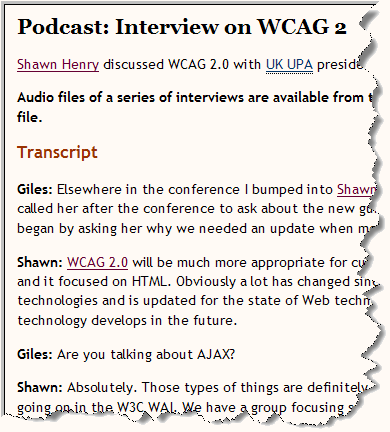Introduction to Web Accessibility
Accessibility in Context
The power of the Web is in its universality.
Access by everyone regardless of disability is an essential aspect.
The Web is fundamentally designed to work for all people, whatever their hardware, software, language, location, or ability. When the Web meets this goal, it is accessible to people with a diverse range of hearing, movement, sight, and cognitive ability.
Thus the impact of disability is radically changed on the Web because the Web removes barriers to communication and interaction that many people face in the physical world. However, when websites, applications, technologies, or tools are badly designed, they can create barriers that exclude people from using the Web.
Accessibility is essential for developers and organizations that want to create high-quality websites and web tools, and not exclude people from using their products and services.
What is Web Accessibility
Web accessibility means that websites, tools, and technologies are designed and developed so that people with disabilities can use them. More specifically, people can:
- perceive, understand, navigate, and interact with the Web
- contribute to the Web
Web accessibility encompasses all disabilities that affect access to the Web, including:
- auditory
- cognitive
- neurological
- physical
- speech
- visual
Web accessibility also benefits people without disabilities, for example:
- people using mobile phones, smart watches, smart TVs, and other devices with small screens, different input modes, etc.
- older people with changing abilities due to ageing
- people with “temporary disabilities” such as a broken arm or lost glasses
- people with “situational limitations” such as in bright sunlight or in an environment where they cannot listen to audio
- people using a slow Internet connection, or who have limited or expensive bandwidth
For a 7-minute video with examples of how accessibility is essential for people with disabilities and useful for everyone in a variety of situations, see:
 Web Accessibility Perspectives Video (YouTube)
Web Accessibility Perspectives Video (YouTube)
Accessibility is Important for Individuals, Businesses, Society
The Web is an increasingly important resource in many aspects of life: education, employment, government, commerce, health care, recreation, and more. It is essential that the Web be accessible in order to provide equal access and equal opportunity to people with diverse abilities. Access to information and communications technologies, including the Web, is defined as a basic human right in the United Nations Convention on the Rights of Persons with Disabilities (UN CRPD).
The Web offers the possibility of unprecedented access to information and interaction for many people with disabilities. That is, the accessibility barriers to print, audio, and visual media can be much more easily overcome through web technologies.
Accessibility supports social inclusion for people with disabilities as well as others, such as:
- older people
- people in rural areas
- people in developing countries
There is also a strong business case for accessibility. As shown in the previous section, accessible design improves overall user experience and satisfaction, especially in a variety of situations, across different devices, and for older users. Accessibility can enhance your brand, drive innovation, and extend your market reach.
Web accessibility is required by law in many situations.
Making the Web Accessible
Web accessibility depends on several components working together, including web technologies, web browsers and other "user agents", authoring tools, and websites.
The W3C Web Accessibility Initiative (WAI) develops technical specifications, guidelines, techniques, and supporting resources that describe accessibility solutions. These are considered international standards for web accessibility; for example, WCAG 2.0 is also an ISO standard: ISO/IEC 40500.
Making Your Website Accessible
Many aspects of accessibility are fairly easy to understand and implement. Some accessibility solutions are more complex and take more knowledge to implement.
It is most efficient and effective to incorporate accessibility from the very beginning of projects, so you don’t need go back and to re-do work.
Evaluating Accessibility
When developing or redesigning a website, evaluate accessibility early and throughout the development process to identify accessibility problems early, when it is easier to address them. Simple steps, such as changing settings in a browser, can help you evaluate some aspects of accessibility. Comprehensive evaluation to determine if a website meets all accessibility guidelines takes more effort.
There are evaluation tools that help with evaluation. However, no tool alone can determine if a site meets accessibility guidelines. Knowledgeable human evaluation is required to determine if a site is accessible.
Examples
Alternative Text for Images

Images should include equivalent alternative text (alt text) in the markup/code.
If alt text isn’t provided for images, the image information is inaccessible, for example, to people who cannot see and use a screen reader that reads aloud the information on a page, including the alt text for the visual image.
When equivalent alt text is provided, the information is available to people who are blind, as well as to people who turn off images (for example, in areas with expensive or low bandwidth). It’s also available to technologies that cannot see images, such as search engines.
Keyboard Input
![]()
Some people cannot use a mouse, including many older users with limited fine motor control. An accessible website does not rely on the mouse; it makes all functionality available from a keyboard. Then people with disabilities can use assistive technologies that mimic the keyboard, such as speech input.
Transcripts for Audio
Just as images aren’t available to people who can’t see, audio files aren’t available to people who can’t hear. Providing a text transcript makes the audio information accessible to people who are deaf or hard of hearing, as well as to search engines and other technologies that can’t hear.
It’s easy and relatively inexpensive for websites to provide transcripts. There are also transcription services that create text transcripts in HTML format.
For More Information
W3C WAI provides a wide range of resources on different aspects of web accessibility standards, education, testing/evaluation, project management, and policy. We encourage you to explore this website, or look through the WAI Resources list.
Digital Accessibility Foundations - Free Online Course provides the foundation you need to make your digital technology accessible.
Back to Top